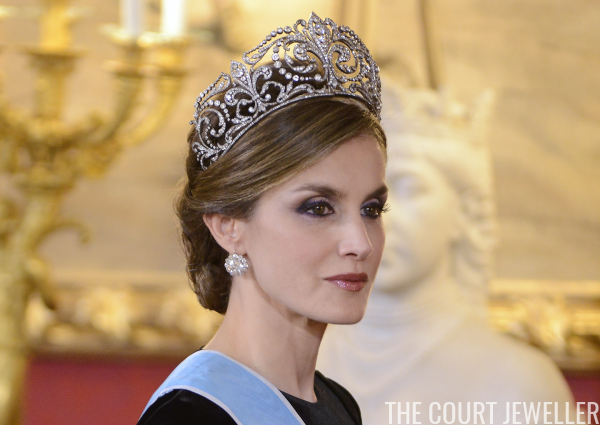 |
| Queen Letizia wears the tiara and earrings from Queen Ena’s joyas de pasar collection (Borja Benito – Pool/Getty Images) |
Spain doesn’t exactly have a collection of crown jewels like some monarchies do, but they do have a unique group of jewels that pass from monarch to monarch: the joyas de pasar, or, “the jewels that are passed on.” Today, we’re looking at this group of jewels, which are mainly reserved for the use of queens regnant and consort in Spain.
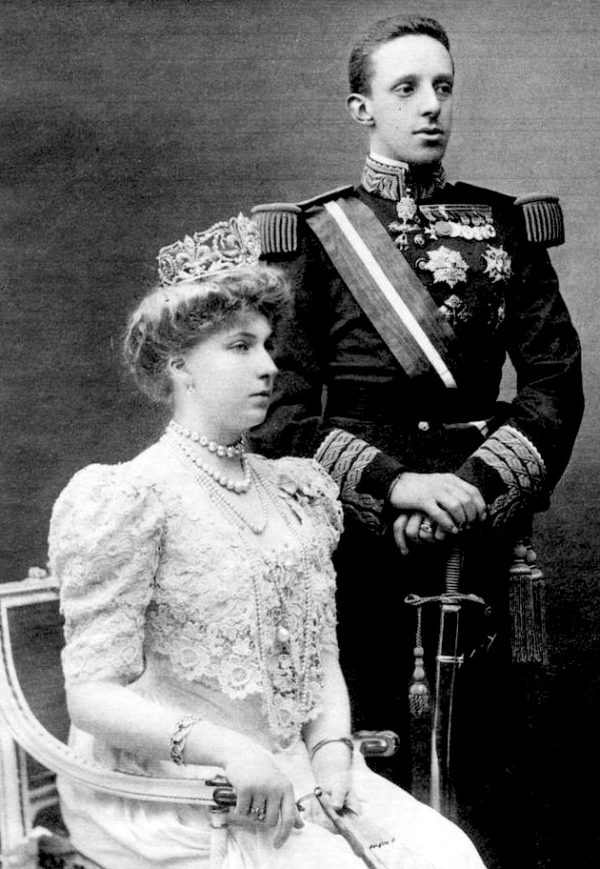 |
| Queen Ena wears several pieces from the joyas de pasar collection in an official photo taken at the time of her wedding in 1906 (Grand Ladies Site) |
The collection was started by Queen Victoria Eugenie of Spain, who is better known to us as Queen Ena. When she made her will in 1963, she included a codicil that designated a group of her jewels to be passed down from monarch to monarch. It was a slightly peculiar decision, as there was no monarch at all in Spain in 1963. Ena’s husband, King Alfonso XIII, had been deposed in a coup in 1931, and she’d been living in exile in Switzerland ever since.
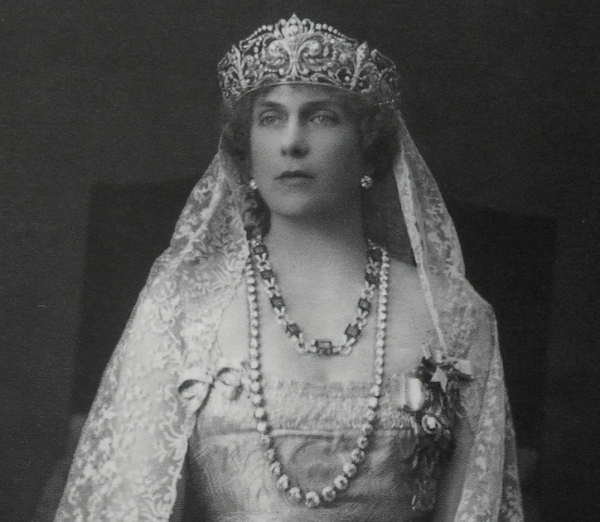 |
| Queen Ena, in formal court dress, wears the tiara, earrings, and diamond collet necklace from the joyas de pasar collection in a portrait, ca. 1920s |
But either Ena believed that the monarchy would indeed be restored, as Generalissimo Franco publicly stated that he intended to do, or she just hoped that the family’s most important jewels would always end up being possessed by the head of the family, instead of being scattered. She noted that she wanted this collection of jewels to go to her son, the Count of Barcelona, adding that she hoped “si es posible” that the jewels would then be passed on from him to his son, Juan Carlos.
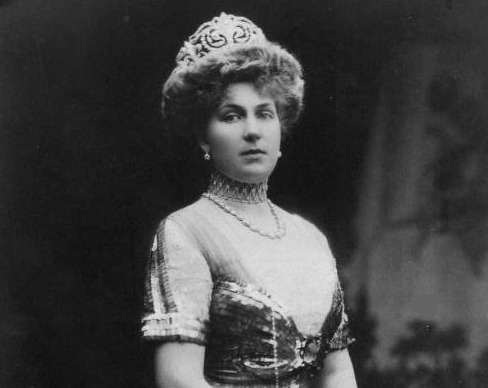 |
| Queen Ena wears the tiara from the joyas de pasar collection (Grand Ladies Site) |
In creating this collection, Queen Ena followed the example of her British grandmother, Queen Victoria, who designated her most important jewels as “heirlooms of the crown,” to be passed directly from monarch to monarch. For Ena, this collection of heirloom jewels included pieces that she received from her husband, King Alfonso XIII, and from Alfonso’s aunt, Infanta Isabella. She noted in her will that she received these jewels “in usufruct” — which means that she was able to use and enjoy the jewels, but that she could not destroy or dispose of them. (She apparently took this seriously. She altered numerous other pieces of her personal jewelry, but she does not appear to have made any significant alterations to this collection.) The collection includes one tiara, three necklaces, a pair of earrings, a pair of matching bracelets, and two brooches.
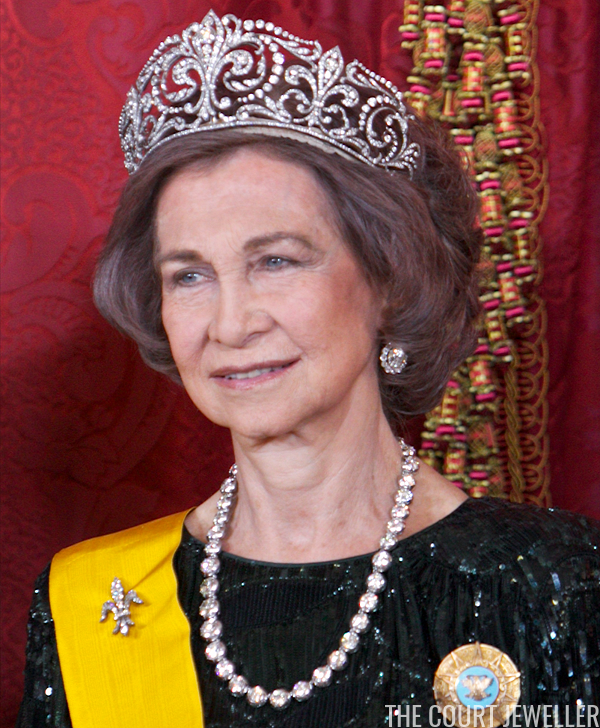 |
| Queen Sofia wears the tiara, diamond collet necklace, and earrings from the joyas de pasar (Pool/Getty Images) |
The tiara from the joyas de pasar collection is Ena’s wedding tiara, the Fleur-de-Lis diadem that is often called “La Buena.” It was made in 1906 by Ansorena, and it was a wedding gift to Ena from her new husband, King Alfonso XIII. Ena describes the tiara in her will as “una diadema de brillantes con tres flores de lis.”
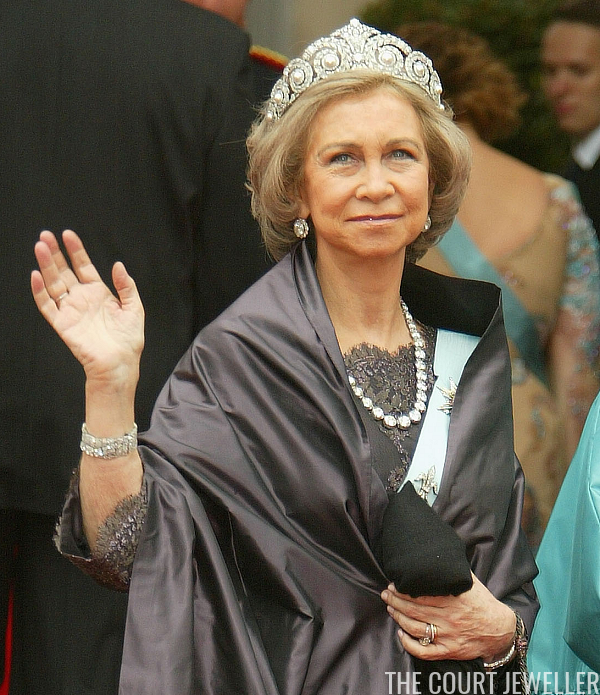 |
| Queen Sofia wears the diamond collet necklace, earrings, and matched bracelets from the joyas de pasar (Pascal Le Segretain/Getty Images) |
Next on the list is “el collar de chatones más grande,” the necklace made of very large diamond collets. This diamond necklace was also a wedding gift from King Alfonso XIII. The necklace appears in various lengths in portraits of Ena; in the picture of Queen Sofia above, you see it in its current state.
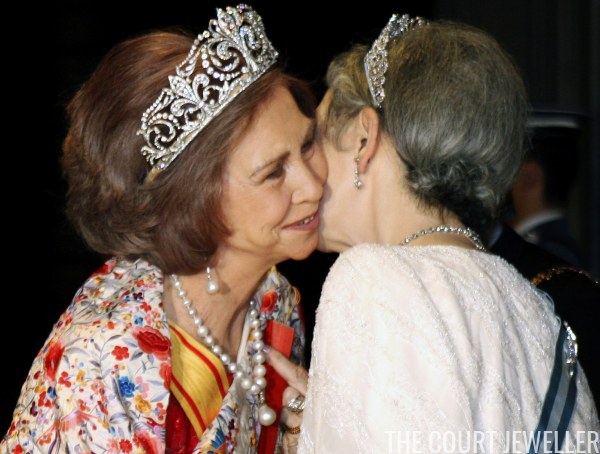 |
| Queen Sofia wears the tiara, the 37 pearl necklace, and the “La Peregrina II” pendant from the joyas de pasar (Koji Sasahara/Getty Images) |
Ena was very precise in her description of the next item on the list: “el collar con treinta y siete perlas grandes,” the necklace made of 37 large pearls. The pearl necklace was — you guessed it — a wedding gift from King Alfonso XIII.
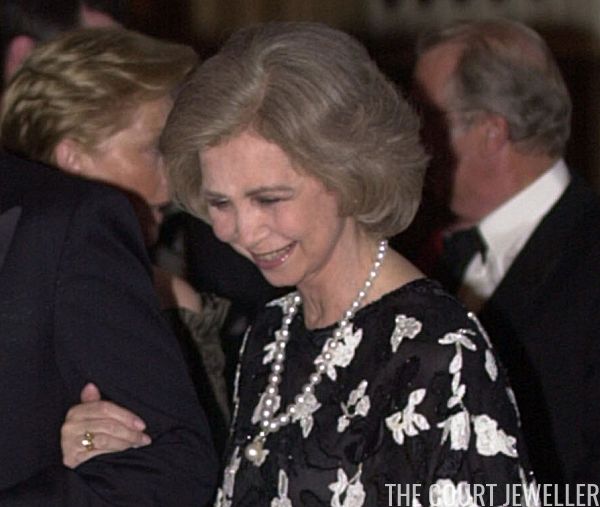 |
| Queen Sofia wears La Peregrina II from the joyas de pasar as a pendant on a pearl necklace (Martin Hayhow/AFP/Getty Images) |
The next item needs a bit of clarification. Ena noted that she wanted to pass along “un broche de brillantes del cual cuelga una perla en forma de pera llamada ‘La Peregrina,'” a diamond brooch from which hangs a pear-shaped pearl called “La Peregrina.” Ena believed that the pear-shaped pearl that she owned was indeed the real La Peregrina — but it’s not. The real Peregrina pearl used to be a part of the Spanish royal collection, but it was carried off by Joseph Bonaparte during the Napoleonic era and sold. (It’s the one that was once owned by Elizabeth Taylor.) The similar pearl in the joyas de pasar collection is usually called La Peregrina II; it was given to Ena by King Alfonso XIII.
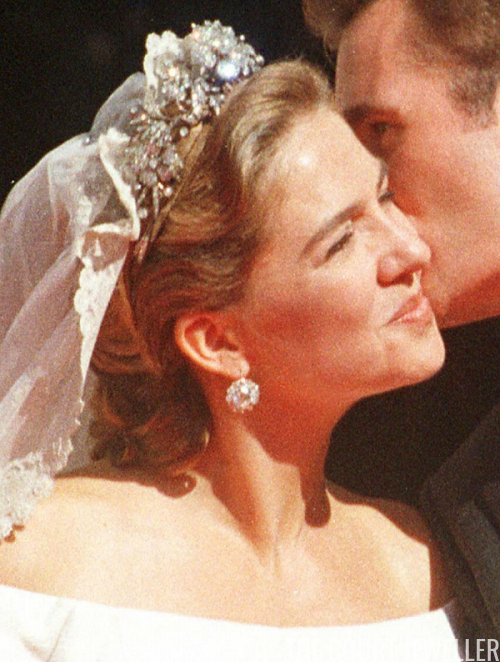 |
| Infanta Cristina wears the diamond cluster earrings from the joyas de pasar on her wedding day (Dominique Faget/AFP/Getty Images) |
The collection also includes a pair of enormous diamond cluster earrings, described by Ena as “un par de pendientes con un brillante grueso y brillantes alrededor.” These were also wedding gifts from King Alfonso XIII. Queen Sofia loaned the earrings to her younger daughter, Infanta Cristina, to wear on her wedding day in 1997.
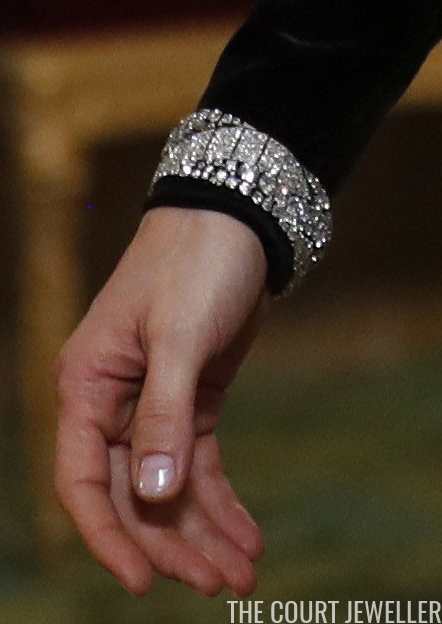 |
| Queen Letizia wears the diamond bracelets (one shown) from the joyas de pasar (CHEMA MOYA/AFP/Getty Images) |
Next up: “dos pulseras iguales de brillantes,” two matching diamond bracelets. The bracelets feature interesting, dynamic details, and they’ve become Queen Letizia’s favored pieces from the set so far.
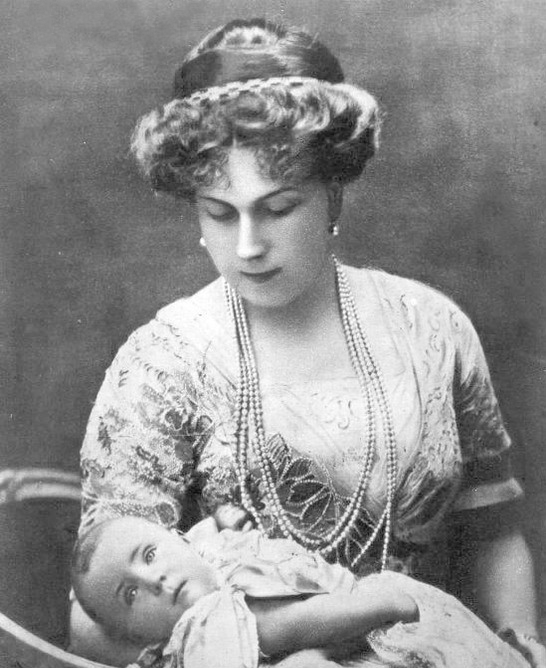 |
| Queen Ena, holding Infanta Maria Cristina, wears four long strands of pearls (Grand Ladies Site) |
The next necklace is made of “cuatro hilos de perlas grandes,” four strands of pearls.
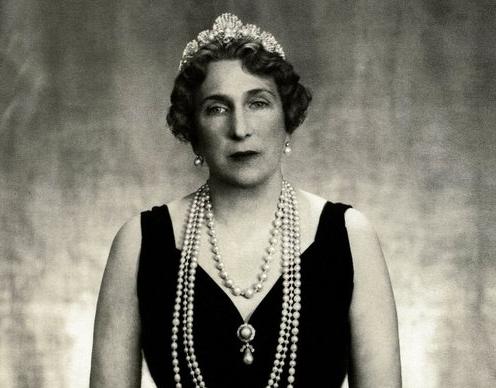 |
| Queen Ena wears the gray pearl cluster brooch with its pendant drop in a portrait, ca. 1920s |
And finally, Ena rounded out the collection with “un broche con perla grande gris pálido rodeada de brillantes y del cual cuelga una perla en forma de pera,” a brooch with a large, pale gray pearl surrounded by diamonds, from which hangs a pear-shaped pearl.
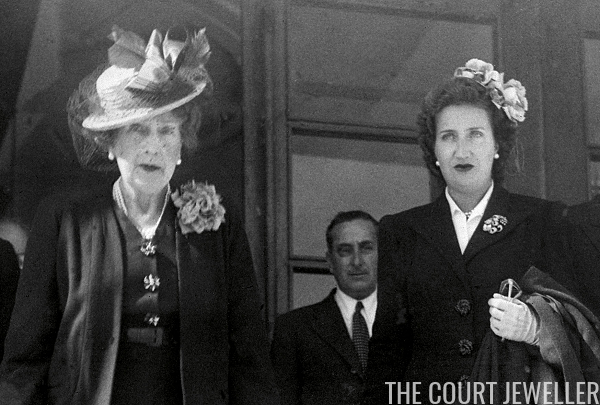 |
| Queen Ena and the Countess of Barcelona, ca. 1935 (AFP/Getty Images) |
When Ena died in 1969, the joyas de pasar were indeed inherited by the Count of Barcelona. He was Ena’s fourth son, but his elder brothers had all either died or renounced their rights to the throne, so he was the designated heir. His wife, Mercedes, wore the joyas de pasar after her mother-in-law’s death.
For various reasons, Franco (the Spanish head of state from 1939 until 1975) decided to skip the Count of Barcelona when restoring the line of succession, selecting his son, Infante Juan Carlos, to be the future king of Spain. Two days after Franco’s death in 1975, the Cortes Generales proclaimed Juan Carlos King of Spain. But his father, still unhappy with Franco’s decision, did not formally renounce his rights to the throne until 1977. Only after that renunciation did Juan Carlos’s wife, Queen Sofia, begin wearing the joyas de pasar in public.
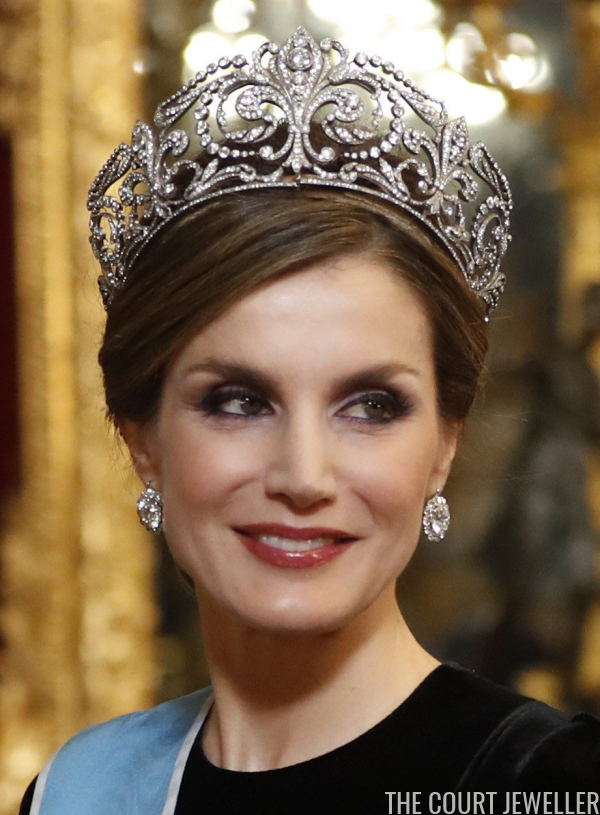 |
| Queen Letizia wears the tiara and earrings from the joyas de pasar (CHEMA MOYA/AFP/Getty Images) |
When King Juan Carlos abdicated in 2014, the joyas de pasar were handed over to a third generation of the family, the new King Felipe VI and Queen Letizia. She wore pieces from the collection in public for the first time during a state visit from the President of Argentina in 2017. Eventually, their daughter, Leonor, will be the first Spanish queen regnant to wear the joyas de pasar.
Leave a Reply